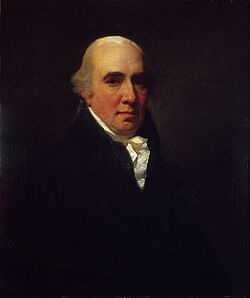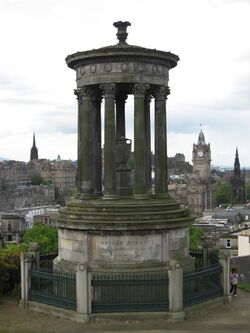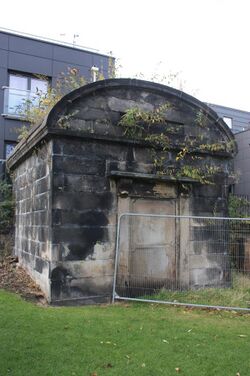Dugald Stewart
Topic: Biography
 From HandWiki - Reading time: 9 min
From HandWiki - Reading time: 9 min
Dugald Stewart | |
|---|---|
 Dugald Stewart as painted by Henry Raeburn, c. 1810. | |
| Born | Edinburgh, Scotland |
| Died | 11 June 1828 (aged 74) Edinburgh, Scotland |
| Nationality | Scottish |
| Alma mater | University of Edinburgh |
| Era | 18th-century philosophy |
| Region | Western philosophy |
| School | Scottish Common Sense Realism |
Main interests | Moral philosophy |
Dugald Stewart FRSE FRS (/ˈdjuːɡəld/; 22 November 1753 – 11 June 1828) was a Scottish philosopher and mathematician. Today regarded as one of the most important figures of the later Scottish Enlightenment, he was renowned as a populariser of the work of Francis Hutcheson and of Adam Smith. Trained in mathematics, medicine and philosophy,[1] his lectures at the University of Edinburgh were widely disseminated by his many influential students. In 1783 he was a joint founder of the Royal Society of Edinburgh. In most contemporary documents he is referred to as Prof Dougal Stewart.[2]
Early life
He was the son of Matthew Stewart (1715–1785), professor of mathematics at the University of Edinburgh (1747–1772), and was born in his father's quarters at Old College. His mother was Marjory Stewart, his father's cousin.
He was educated at the High School and the University of Edinburgh, where he studied mathematics and moral philosophy under Adam Ferguson. In 1771, in the hope of gaining a Snell Exhibition Scholarship and proceeding to Oxford to study for the English Church, he went to the University of Glasgow to attend the classes of Thomas Reid. To Reid he later owed his theory of morality. In Glasgow, Stewart boarded in the same house as Archibald Alison, author of the Essay on Taste, and a lasting friendship sprang up between them.[3]
After a single session in Glasgow University, at the age of nineteen, Dugald was asked by his father, whose health was beginning to fail, to give his mathematical classes in the University of Edinburgh. After three years there, in 1775, Dugald was elected joint professor of mathematics in conjunction with his father. Three years later Ferguson was appointed secretary to the commissioners sent out to the American colonies, and at his request Stewart lectured as his substitute during the session 1778–1779, delivering an original course of lectures on morals.[3] In his early years he was influenced by Lord Monboddo, with whom he corresponded.
Professor at Edinburgh
In 1785 Stewart succeeded Ferguson in the chair of moral philosophy, which he filled for twenty-five years, making it a centre of intellectual and moral influence. Young men were attracted by his reputation from England, Europe and America. Greatly influenced by the Irish Presbyterian Francis Hutcheson who, in the preceding generation, had held the chair of moral philosophy at the University of Glasgow, Stewart's course on moral philosophy embraced, besides ethics proper, lectures on political philosophy or the theory of government.[3]
William Drennan, whose father Thomas Drennan had been secretary to Hutcheson, and who 1791 moved the formation of the Society of United Irishmen in Belfast and in Dublin, was a student and friend.[4] It is from Stewart that Drennan is said to have "imbibed the classical tradition of republican theory, in its most famous English embodiment in the works of John Locke, and its contemporary reincarnation in the works of Richard Price and Joseph Priestley".[5]
Stewart's dissident rationalism greatly influenced Maria Edgeworth and Elizabeth Hamilton. They drew extensively on his work in constructing educational programmes that rested on the assumption that women, and especially mothers, were intellectually capable of understanding the importance of the early association of ideas in the training of children's emotions and reasoning powers.[6]
Stewart spent the summers of 1788 and 1789 in France, where he met Suard, Degérando, and Raynal, and came to sympathise with the revolutionary movement.[3] His political teaching, after the French Revolution , drew suspicion on him. His Edinburgh residence for several years was Whitefoord House on the Royal Mile.[7]
From 1800 to 1801, Stewart gave lectures to undergraduate students on the subject of political economy, the first person to do so.[8] Stewart made himself the leading disciple of Adam Smith and, after Smith's death became his first biographer. In 1793 Stewart had read his Account of the Life and Writings of Adam Smith to the Royal Society of Edinburgh.
In 1797 he appears as "Dougald Stewart, professor of moral philosophy" living at Lothian House near the bottom of the Canongate.[9]
Family
In 1783 Stewart married Helen Bannatyne (a distant cousin),[10] who died in 1787, leaving him an only son, Matthew Stewart FRSE (1784-1851). In 1790 he married Helen D'Arcy Cranstoun, sister of George Cranstoun. His second wife was well-born and accomplished, and he was in the habit of submitting to her criticism whatever he wrote. They had a son and a daughter. The son's death in 1809 brought about his retirement from the active duties of his chair.[3]
His sister, Janet Stewart, married Rev Thomas Miller of Cumnock, and they were parents to Dr Patrick Miller FRSE (1782-1871).[11]
Later life
In 1806 Stewart received in lieu of a pension the nominal office of the writership of the Edinburgh Gazette, with a salary of £300. When he ceased lecturing during the session of 1809–1810, his place was taken, at his own request, by Thomas Brown, who in 1810 was appointed conjoint professor. On the death of Brown in 1820 Stewart retired altogether from the professorship. His successor was John Wilson, known as "Christopher North".[3]
From 1809 onwards Stewart lived mainly at Kinneil House, Bo'ness, which was placed at his disposal by the Duke of Hamilton.[3] He was elected to the American Philosophical Society in 1791.[12] In June 1814 Stewart was elected a Fellow of the Royal Society.[13] He was elected a Foreign Honorary Member of the American Academy of Arts and Sciences in 1817.[14]
Freemasonry
Like his father, Rev Dr Matthew Stewart, he was a Scottish Freemason. He was Initiated in the Lodge of his father - Lodge Canongate Kilwinning, No.2, on 4 December 1775.[15]
His friend and fellow Freemason, Robert Burns, made him an honorary member of Lodge St David, Tarbolton, No. 133, on 25 July 1787. This was whilst Stewart was staying at the family seat at Catrine, Ayrshire.[16]
Death
In 1822 he was struck with paralysis, but recovered a fair degree of health, sufficient to enable him to resume his studies. He died in Edinburgh on 11 June 1828, where he was buried in Canongate Churchyard, close to his Edinburgh residence. He is buried in an enclosed vault in the lower section, on its west side.
Memorials
In 1831, and of great public note, a monument was erected by the city on Calton Hill.[3] This is to a design by William Henry Playfair and holds a commanding position in the city skyline, forming one of the city's iconic landmarks.[17]
His memory is also honoured by the "Dugald Stewart Building" (erected 2011) for the University of Edinburgh to house its Philosophy Department, on Charles Street, off George Square.
Works
Stewart as a student in Glasgow wrote an essay on Dreaming. In 1792 he published the first volume of the Elements of the Philosophy of the Human Mind; the second volume appeared in 1814, the third not till 1827. In 1793 he printed a textbook, Outlines of Moral Philosophy, which went through many editions; and in the same year he read before the Royal Society of Edinburgh his Account of the Life and Writings of Adam Smith. Similar memoirs of Robertson the historian and of Reid were afterwards read before the same body and appear in his published works.[3]
In 1805 Stewart published pamphlets defending John Leslie against the charges of unorthodoxy made by the presbytery of Edinburgh. In 1810 appeared the Philosophical Essays,[18] in 1814 the second volume of the Elements, in 1811 the first part and in 1821 the second part of the "Dissertation" written for the Encyclopædia Britannica Supplement, entitled "A General View of the Progress of Metaphysical, Ethical, and Political Philosophy since the Revival of Letters." In 1827 he published the third volume of the Elements, and in 1828, a few weeks before his death, The Philosophy of the Active and Moral Powers.[3]
Stewart's works were edited in 11 vols. (1854–1858) by Sir William Hamilton and completed with a memoir by John Veitch.[3]
Influence
Among Stewart's pupils were Lord Palmerston, Sir Walter Scott, Francis Jeffrey, Henry Thomas Cockburn, Francis Horner, Sydney Smith, John William Ward, Lord Brougham, Dr. Thomas Brown, James Mill, Sir James Mackintosh and Sir Archibald Alison.[3]
His reputation rested as much on his eloquence, populism, and style as on original work.[19] He was principally responsible for making the "Scottish philosophy" predominant in early 19th-century Europe.[19] In the second half of the century, Stewart's reputation fell to that of a follower of the work of Thomas Reid.[3]
Stewart upheld Reid's psychological method and expounded the Scottish Common Sense Realism,[20] which was attacked by James Mill and John Stuart Mill. Part of his originality lay in his incorporation of elements of moderate empiricism and the French ideologists Laromiguière, Cabanis and Destutt de Tracy. He opposed the argument of ontology, and Condillac's sensationalism. Immanuel Kant, he said, he could not understand.[21]
References
- ↑ Eddy, Matthew Daniel (2006). "The medium of signs: nominalism, language and the philosophy of mind in the early thought of Dugald Stewart". Studies in the History and Philosophy of Science of Biological and Biomedical Sciences 37 (3): 373–393. doi:10.1016/j.shpsc.2006.06.013. PMID 16980184. https://www.academia.edu/3426698.
- ↑ Edinburgh Post Office Directories 1800 to 1828 etc
- ↑ 3.00 3.01 3.02 3.03 3.04 3.05 3.06 3.07 3.08 3.09 3.10 3.11 3.12
 One or more of the preceding sentences incorporates text from a publication now in the public domain: Chisholm, Hugh, ed (1911). "Stewart, Dugald". Encyclopædia Britannica. 25 (11th ed.). Cambridge University Press. pp. 913-914.
One or more of the preceding sentences incorporates text from a publication now in the public domain: Chisholm, Hugh, ed (1911). "Stewart, Dugald". Encyclopædia Britannica. 25 (11th ed.). Cambridge University Press. pp. 913-914.
- ↑ McBride, Ian (1993). "William Drennan and the Dissenting Tradition". in Dickson, David. The United Irishmen : Republicanism, Radicalism, and Rebellion. Dublin, Ireland: The Lilliput Press. pp. 49–61. ISBN 1-874675-19-8. OCLC 29878617.
- ↑ Johnston, Kenneth R. (2013). Unusual Suspects: Pitt's Reign of Alarm and the Lost Generation of the 1790s. Oxford: Oxford University Press. p. 146. ISBN 9780199657803.
- ↑ Randall, Jane (2013). "'Elementary Principles of Education': Elizabeth Hamilton, Maria Edgeworth and the Uses of Common Sense Philosophy". History of European Ideas 39 (5): 613–630. doi:10.1080/01916599.2012.735136. https://doi.org/10.1080/01916599.2012.735136. Retrieved 7 November 2020.
- ↑ Edinburgh and District: Ward Lock Travel Guide 1930
- ↑ The early years at University of Edinburgh School of Economics's official website. Accessed 24 February 2013.
- ↑ Edinburgh Post Office Directory 1797
- ↑ "Matthew Stewart - Biography". http://www-groups.dcs.st-and.ac.uk/history/Biographies/Stewart.html.
- ↑ Former Fellows of The Royal Society of Edinburgh 1783 – 2002 Biographical Index Part Two. The Royal Society of Edinburgh. July 2006. ISBN 0-902198-84-X. https://www.rse.org.uk/cms/files/fellows/biographical_index/fells_indexp2.pdf. Retrieved 5 September 2020.
- ↑ "Dugald Stewart". American Philosophical Society. https://search.amphilsoc.org/memhist/search?creator=Dugald+Stewart.
- ↑ "Library and Archive Catalogue". Royal Society. http://www2.royalsociety.org/DServe/dserve.exe?dsqIni=Dserve.ini&dsqApp=Archive&dsqCmd=Show.tcl&dsqDb=Persons&dsqPos=3&dsqSearch=%28Surname%3D%27stewart%27%29.
- ↑ "Book of Members, 1780–2010: Chapter S". American Academy of Arts and Sciences. http://www.amacad.org/publications/BookofMembers/ChapterS.pdf.
- ↑ History of the Lodge Canongate Kilwinning, No.2, compiled from the records 1677-1888. By Alan MacKenzie. 1888. P.245.
- ↑ Weir, John (1996). Robert Burns, the Freemason. Addlestone: Lewis Masonic. ISBN 0-85318-213-2. OCLC 37245413.
- ↑ Buildings of Scotland: Edinburgh by Gifford, Mcwilliam and Walker
- ↑ "Review of Philosophical Essays by Dugald Stewart". The Quarterly Review 6: 1–37. October 1811. https://babel.hathitrust.org/cgi/pt?id=uc1.c031993806;view=1up;seq=13.
- ↑ 19.0 19.1 "Dugald Stewart 1753-1828, Scottish Philosopher". http://www.scottishphilosophy.org/dugaldstewart.html.
- ↑ Selections from the Scottish Philosophy of Common Sense, ed. by G. A. Johnston (1915), essays by Thomas Reid, Adam Ferguson, James Beattie, and Dugald Stewart (online version).
- ↑ Jonathan Friday (2005): Dugald Stewart on Reid, Kant and the Refutation of Idealism, British Journal for the History of Philosophy, 13:2, 263–286
Further reading
- Corsi, Pietro. "The heritage of Dugald Stewart: Oxford philosophy and the method of political economy." Nuncius (1987) 2#2 pp: 89-144 (online).
- Haakonssen, Knud. "From moral philosophy to political economy: the contribution of Dugald Stewart." in Philosophers of the Scottish Enlightenment (1984), pp. 211–32.
- Rashid, Salim. "Dugald Stewart, 'Baconian' Methodology, and Political Economy." Journal of the History of Ideas (1985): 245-257 (online on JSTOR).
- Wood, Paul. "Dugald Stewart and the Invention of “the Scottish Enlightenment”." The Scottish Enlightenment: Essays in Reinterpretation (2000), pp. 1–35.
Primary sources
- Stewart, Dugald, and John Veitch. The collected works of Dugald Stewart (1877) (online).
External links
- O'Connor, John J.; Robertson, Edmund F., "Dugald Stewart", MacTutor History of Mathematics archive, University of St Andrews, http://www-history.mcs.st-andrews.ac.uk/Biographies/Stewart_Dugald.html.
- Dugald Stewart at The Online Library of Liberty
- Lodge Canongate Kilwinning, No.2
- Grand Lodge of Scotland
- Freemasonry and the Leaders of Victorian Britain
 |
 KSF
KSF

